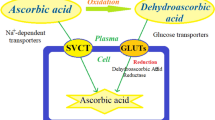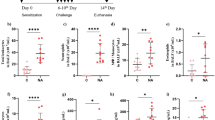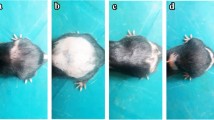Abstract
Chemical alteration of the glucocorticoid, methylprednisolone, has led to the introduction of a new class of compounds called the 21-aminosteroids (21-ASs). The purpose of this study was to investigate the effect of the 21-AS, U74389G, on silica-induced acute lung injury. Male Fischer 344 rats were treated intraperitoneally with saline or U74389G in a total dose of 15 mg/kg divided into three injections of 5 mg/kg separated by 4 h. Following the first treatment, animals from the two groups were intratracheally instilled with silica (10 mg/100 g body wt in 0.5 ml of saline) or saline vehicle (0.5 ml). Twenty-four hours after the instillations, bronchoalveolar lavage (BAL) was performed. In the animals not receiving U74389G, marked increases in total protein, (β-glucuronidase, and lactate dehydrogenase (LDH) activities and number of neutrophils (PMNs) were demonstrated in the BAL fluid of the silica-treated animals compared to their controls. Silica also caused dramatic increases in the luminol-dependent chemiluminescence (CL) of lung tissue and BAL cells. The CL reaction was decreased by superoxide dismutase (SOD) andN-nitro-l-arginine methyl ester hydrochloride (L-NAME), a nitric oxide (NO) synthase inhibitor. In animals treated with U74389G, there was attenuation of the silica-induced increases in biochemical, cellular, and chemiluminescent indices of damage. This study demonstrates that U74389G significantly reduces acute lung injury caused by the intratracheal instillation of silica, and this drug may be of potential value for treatment of lung diseases in which damage caused by reactive oxygen species has been implicated.
Similar content being viewed by others
References
Kehrl, J. H., andA. S. Fauci. 1983. The clinical use of glucocorticoids.Ann. Allergy 50:2–8.
DiRosa, M., A. Calignano, R. Carnuccio, A. Ialenti, andL. Sautebin. 1985. Multiple control of inflammation by glucocorticoids.Agents Actions 17:284–289.
Seale, J. P., andM. R. Compton. 1986. Side effects of corticosteroid agents.Med. J. Aust. 144:139–142.
Jacobsen, E. J., J. M. McCall, D. E. Ayer, F. J. van Doornik, J. R. Palmer, K. L. Belonga, J. M. Braughler, E. D. Hall, D. J. Houser, M. A. Krook, andT. A. Runge. 1990. Novel 21-aminosteroids that inhibit iron-dependent lipid peroxidation and protect against central nervous system trauma.J. Med. Chem. 33:1145–1151.
McCall, J. M., J. M. Braughler, andE. D. Hall. 1987. A new class of compounds for stroke and trauma: Effects of 21-aminosteroids on lipid peroxidation.Acta Anaesth. Belg. 38:417–420.
Hall, E. D. 1987. Beneficial effects of the 21-aminosteroid U74006F in acute CNS trauma and hypovolemic shock.Acta Anaesth. Belg. 38:421–425.
Hall, E. D. 1988. Effects of the 21-aminosteroid U74006F on post-traumatic spinal cord ischemia in cats.J. Neurosurg. 68:462–465.
Aoki, N., andA. M. Lefer. 1990. Protective effect of a novel nonglucocorticoid 21-aminosteroid (U74006F) during traumatic shock in rats.J. Cardiovasc. Pharmacol. 15:205–210.
Chumas, P. D., M. R. Del Bigio, J. M. Drake, andU. I. Tour. 1993. A comparison of the protective effect of dexamethasone to other potential prophylactic agents in a neonatal rat model of cerebral hypoxia-ischemia.J. Neurosurg. 79:414–420.
Horton, J. W., andP. B. Walker. 1993. Oxygen radicals, lipid peroxidation, and permeability changes after intestinal ischemia and reperfusion.J. Appl. Physiol. 74:1515–1520.
Stanley, J. J., J. R. Goldblum, T. S. Frank, G. B. Zelenock, andL. G. D'Alecy. 1993. Attenuation of renal reperfusion injury in rats by the 21-aminosteroid U74006F.J. Vasc. Surg. 17:685–689.
Myers, S. I., R. Hernandez, D. J. White, andJ. W. Horton. 1993. Burn injury decreased splanchnic PG12 release is restored by treatment with lazaroid.Prostaglandins 45:535–546.
Bowden, D. 1987. Macrophages, dust, and pulmonary diseases.Exp. Lung Res. 12:89–107.
Lapp, N. L., andV. Castranova. 1993. How silicosis and coal worker's pneumoconiosis develop—a cellular assessment.In Occupational Medicine: State of the Art Reviews—The Mining Industry, Vol. 8, No. 1. D.E. Banks, editor. Hanley and Belfus, Philadelphia, 35–56.
Richards, I. M., R. L. Griffin, S. F. Fidler, andE. J. Jacobsen. 1993. Effect of the 21-aminosteroid, U74389F, on hyperoxic lung injury in rats.Agents Actions 39:C136-C138.
Henderson, R. F. 1984. Use of bronchoalveolar lavage to detect lung damage.Environ. Health Perspect. 56:112–129.
Khan, M. F., andG. S. D. Gupta. 1991. Cellular and biochemical indices of bronchoalveolar lavage for detection of lung injury following insult by airborne toxicants.Toxicol. Lett. 58:239–255.
Hartree, E. 1972. Determination of protein: A modification of the Lowry method that gives a linear photometric response.Anal. Biochem. 48:422–427.
Lockard, V., andR. Kennedy. 1976. Alterations in rabbit alveolar macrophages as a result of traumatic shock.Lab. Invest. 35:501–506.
Wroblewski, F., andJ. S. LaDue. 1955. Lactic acid dehydrogenase activity in blood.Proc. Soc. Exp. Biol. Med. 90:210–213.
Goodman, G. B., P. D. Kaplan, I. Stachura, V. Castranova, W. H. Pailes, andN. L. Lapp. 1992. Acute silicosis responding to corticosteroid therapy.Chest 101:366–370.
Henderson, R. F., J. R. Harkema, J. A. Hotchkiss, andD. S. Boehme. 1991. Effect of blood leukocyte depletion on the inflammatory response of the lung to quartz.Toxicol. Appl. Pharmacol. 109:127–136.
Weiss, S. I., andA. F. LoBuglio. 1982. Biology of disease: phagocyte-generated oxygen metabolites and cellular injury.Lab. Invest. 47:5–18.
Wang, J. F., P. Komarov, H. Sies, andH. DeGroot. 1991. Combination of nitric oxide synthase to luminol dependent chemiluminescence by phorbol ester activated Kupffer cells.Biochem. J. 279:311–314.
Radi, R., T. P. Cosgrove, J. S. Beckman, andB. A. Freeman. 1993. Peroxynitrite-induced luminol chemiluminescence.Biochem. J. 290:51–57.
Radi, R., J. S. Beckman, K. Bush, andB. A. Freeman. 1991. Peroxynitrite oxidation of sulphydryls.J. Biol. Chem. 266:4244–4250.
Moreno, J. J., andW. A. Pryor. 1992. Inactivation of alpha-1-proteinase inhibitor by peroxynitrite.Chem. Res. Toxicol. 5:425–431.
McCall, T., R. M. J. Palmer, andS. Moncada. 1991. Induction of nitric oxide synthase in rat peritoneal neutrophils and its inhibition by dexamethasone.Eur. J. Immunol. 21:2523–2527.
Braughler, J. M., J. F. Pregenzer, R. L. Chase, L. A. Duncan, E. J. Jacobsen, andJ. M. McCall. 1987. Novel 21-aminosteroids as potent inhibitors of iron-dependent lipid peroxidation.J. Biol. Chem. 262:10438–10440.
Braughler, J. M., R. L. Chase, G. L. Neff, P. A. Yonkers, J. S. Day, E. D. Hall, V. H. Sethy, andR. A. Lahti. 1988. A new 21-aminosteroid antioxidant lacking glucorticoid activity stimulates adrenocorticotropin secretion and blocks arachidonic acid release from mouse pituitary tumor (AtT-20) cells.J. Pharmacol. Exp. Ther. 244:423–427.
Barnes, P. J., andI. Adcock. 1993. Anti-inflammatory actions of steroids: Molecular mechanisms.TiPS 14:436–441.
Author information
Authors and Affiliations
Rights and permissions
About this article
Cite this article
Antonini, J.M., Van Dyke, K., DiMatteo, M. et al. Attenuation of acute inflammatory effects of silica in rat lung by 21-aminosteroid, U74389G. Inflammation 19, 9–21 (1995). https://doi.org/10.1007/BF01534376
Issue Date:
DOI: https://doi.org/10.1007/BF01534376




